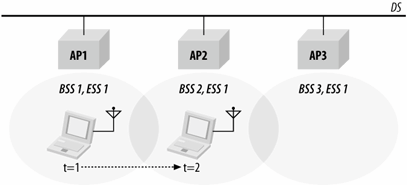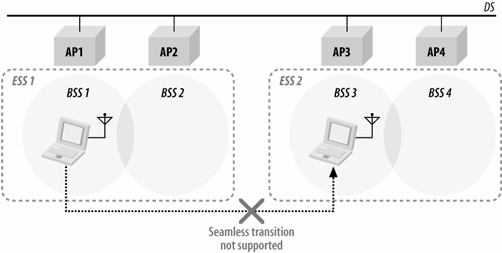Mobility Support
Mobility is the usually the primary motivation for deploying an 802.11 network. Transmitting data frames while the station is moving will do for data communications what mobile telephony did for voice.
802.11 provides mobility between basic service areas at the link layer. However, it is not aware of anything that happens above the link layer. When designing deploying 802.11, networks engineers must take care so that the seamless transition at the radio layer is also supported at the network protocol layer that the station IP address can be preserved. As far as 802.11 is concerned, there are three types of transitions between access points:
No transition
When stations do not move out of their current access point's service area, no transition is necessary. This state occurs because the station is not moving or it is moving within the basic service area of its current access point.[*] (Arguably, this isn't a transition so much as the absence of a transition, but it is defined in the specification.)
[*] Although my explanation makes it sound as if the "no motion" and "local motion" substates are easily distinguishable, they are not. The underlying physics of RF propagation can make it impossible to tell whether a station is moving because the signal strength can vary with the placement of objects in the room, which, of course, includes the people who may be walking around.
BSS transition
Stations continuously monitor the signal strength and quality from all access points administratively assigned to cover an extended service area. Within an extended service area, 802.11 provides MAC layer mobility. Stations attached to the distribution system can send out frames addressed to the MAC address of a mobile station and let the access points handle the final hop to the mobile station. Distribution system stations do not need to be aware of a mobile station's location as long as it is within the same extended service area.
Figure 2-9 illustrates a BSS transition. The three access points in the picture are all assigned to the same ESS. At the outset, denoted by t=1, the laptop with an 802.11 network card is sitting within AP1's basic service area and is associated with AP1. When the laptop moves out of AP1's basic service area and into AP2's at t=2, a BSS transition occurs. The mobile station uses the reassociation service to associate with AP2, which then starts sending frames to the mobile station.
BSS transitions require the cooperation of access points. In this scenario, AP2 needs to inform AP1 that the mobile station is now associated with AP2. 802.11 does not specify the details of the communications between access points during BSS transitions.
Note that even though two access points are members of the same extended set, they may nonetheless be connected by a router, which is a layer 3 boundary. In such a scenario, there is no way to guarantee seamless connectivity using 802.11 protocols only.
Figure 2-9. BSS transition

ESS transition
An ESS transition refers to the movement from one ESS to a second distinct ESS. 802.11 does not support this type of transition, except to allow the station to associate with an access point in the second ESS once it leaves the first. Higher-layer connections are almost guaranteed to be interrupted. It would be fair to say that 802.11 supports ESS transitions only to the extent that it is relatively easy to attempt associating with an access point in the new extended service area. Maintaining higher-level connections requires support from the protocol suites in question. In the case of TCP/ IP, Mobile IP is required to seamlessly support an ESS transition.
Figure 2-10 illustrates an ESS transition. Four basic service areas are organized into two extended service areas. Seamless transitions from the lefthand ESS to the righthand ESS are not supported. ESS transitions are supported only because the mobile station will quickly associate with an access point in the second ESS. Any active network connections are likely to be dropped when the mobile station leaves the first ESS.
Designing Networks for Mobility
Most networks are designed so that a group of access points provides access to a group of resources. All the access points under control of the networking organization are assigned to the same SSID, and clients are configured to use that SSID when connecting to the wireless network.
As client systems move around, they continuously monitor network connectivity, and shift between access points in the same SSID. 802.11 ensures that clients will be able to move associations between the access points in the same SSID, but network architects must build the network to support mobile clients. Small networks are often built on a single VLAN with a single subnet, in which case there is no need to worry about mobility. Larger networks that span subnet boundaries must apply some additional technology to provide mobility support. Many products can work
Figure 2-10. ESS transition

with a VLAN core, which allows clients to always attach to the same VLAN throughout an organization. New products even allow dynamic VLAN assignment based on authentication data. When users connect to the network, they are attached to the same VLAN everywhere; the switched network simply requires that the wireless LAN device tag frames appropriately. Some products support the Mobile IP standard, or use VPN technology creatively. Trade-offs between all the different mobility strategies are discussed in Chapter 21.
In practice, ESS transitions are quite rare. They usually only occur when users leave one administrative domain for another (say, the corporate network for a hot spot), in which case the two networks in question would have different IP addresses and no trust relationship to transparently attach a client without interrupting network-layer connectivity.
Proprietary mobility systems
Many vendors, especially those who have designed products to build large-scale network environments, have designed their own protocols and procedures for mobility. When I started revising this book, one of the big problems with 802.11 was that it generally required a single IP subnet across an entire roaming area. As a result, wireless LAN deployment often required substantial architecture work as well as major backbone re-engineering efforts. Several vendors rushed to fill the gap by implementing proprietary protocols that enabled sessions to move quickly between access points over arbitrary network topologies. Basic concepts for these solutions will be discussed in the deployment section of this book.
Introduction to Wireless Networking
- Introduction to Wireless Networking
- Why Wireless?
- What Makes Wireless Networks Different
- A Network by Any Other Name...
Overview of 802.11 Networks
- Overview of 802.11 Networks
- IEEE 802 Network Technology Family Tree
- 11 Nomenclature and Design
- 11 Network Operations
- Mobility Support
11 MAC Fundamentals
- 11 MAC Fundamentals
- Challenges for the MAC
- MAC Access Modes and Timing
- Contention-Based Access Using the DCF
- Fragmentation and Reassembly
- Frame Format
- Encapsulation of Higher-Layer Protocols Within 802.11
- Contention-Based Data Service
- Frame Processing and Bridging
11 Framing in Detail
- 11 Framing in Detail
- Data Frames
- Control Frames
- Management Frames
- Frame Transmission and Association and Authentication States
Wired Equivalent Privacy (WEP)
- Wired Equivalent Privacy (WEP)
- Cryptographic Background to WEP
- WEP Cryptographic Operations
- Problems with WEP
- Dynamic WEP
User Authentication with 802.1X
- User Authentication with 802.1X
- The Extensible Authentication Protocol
- EAP Methods
- 1X: Network Port Authentication
- 1X on Wireless LANs
11i: Robust Security Networks, TKIP, and CCMP
- 11i: Robust Security Networks, TKIP, and CCMP
- The Temporal Key Integrity Protocol (TKIP)
- Counter Mode with CBC-MAC (CCMP)
- Robust Security Network (RSN) Operations
Management Operations
- Management Operations
- Management Architecture
- Scanning
- Authentication
- Preauthentication
- Association
- Power Conservation
- Timer Synchronization
- Spectrum Management
Contention-Free Service with the PCF
- Contention-Free Service with the PCF
- Contention-Free Access Using the PCF
- Detailed PCF Framing
- Power Management and the PCF
Physical Layer Overview
- Physical Layer Overview
- Physical-Layer Architecture
- The Radio Link
- RF Propagation with 802.11
- RF Engineering for 802.11
The Frequency-Hopping (FH) PHY
- The Frequency-Hopping (FH) PHY
- Frequency-Hopping Transmission
- Gaussian Frequency Shift Keying (GFSK)
- FH PHY Convergence Procedure (PLCP)
- Frequency-Hopping PMD Sublayer
- Characteristics of the FH PHY
The Direct Sequence PHYs: DSSS and HR/DSSS (802.11b)
- The Direct Sequence PHYs: DSSS and HR/DSSS (802.11b)
- Direct Sequence Transmission
- Differential Phase Shift Keying (DPSK)
- The Original Direct Sequence PHY
- Complementary Code Keying
- High Rate Direct Sequence PHY
11a and 802.11j: 5-GHz OFDM PHY
- 11a and 802.11j: 5-GHz OFDM PHY
- Orthogonal Frequency Division Multiplexing (OFDM)
- OFDM as Applied by 802.11a
- OFDM PLCP
- OFDM PMD
- Characteristics of the OFDM PHY
11g: The Extended-Rate PHY (ERP)
- 11g: The Extended-Rate PHY (ERP)
- 11g Components
- ERP Physical Layer Convergence (PLCP)
- ERP Physical Medium Dependent (PMD) Layer
A Peek Ahead at 802.11n: MIMO-OFDM
11 Hardware
- 11 Hardware
- General Structure of an 802.11 Interface
- Implementation-Specific Behavior
- Reading the Specification Sheet
Using 802.11 on Windows
11 on the Macintosh
Using 802.11 on Linux
- Using 802.11 on Linux
- PCMCIA Support on Linux
- Linux Wireless Extensions and Tools
- Agere (Lucent) Orinoco
- Atheros-Based cards and MADwifi
- 1X on Linux with xsupplicant
Using 802.11 Access Points
- Using 802.11 Access Points
- General Functions of an Access Point
- Power over Ethernet (PoE)
- Selecting Access Points
- Cisco 1200 Access Point
- Apple AirPort
Logical Wireless Network Architecture
- Logical Wireless Network Architecture
- Evaluating a Logical Architecture
- Topology Examples
- Choosing Your Logical Architecture
Security Architecture
- Security Architecture
- Security Definition and Analysis
- Authentication and Access Control
- Ensuring Secrecy Through Encryption
- Selecting Security Protocols
- Rogue Access Points
Site Planning and Project Management
- Site Planning and Project Management
- Project Planning and Requirements
- Network Requirements
- Physical Layer Selection and Design
- Planning Access-Point Placement
- Using Antennas to Tailor Coverage
11 Network Analysis
11 Performance Tuning
Conclusions and Predictions
EAN: 2147483647
Pages: 179
